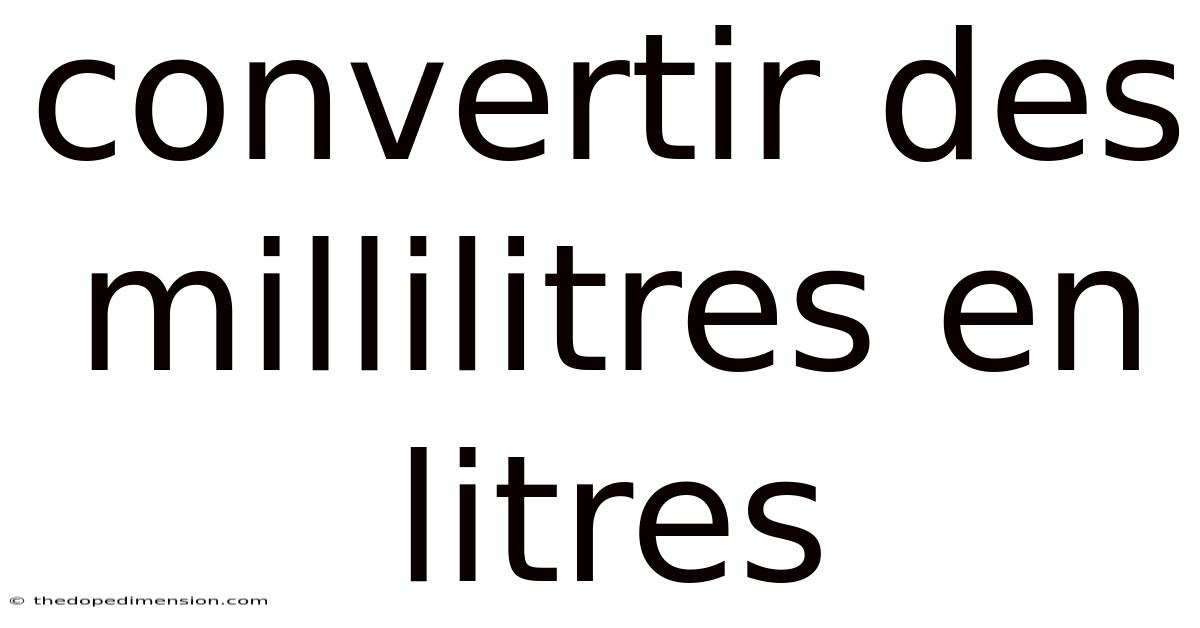Convertir Des Millilitres En Litres
thedopedimension
Sep 09, 2025 · 4 min read

Table of Contents
Converting Milliliters to Liters: A Comprehensive Guide
Understanding volume conversions is crucial in various fields, from cooking and baking to scientific research and engineering. This comprehensive guide will walk you through the process of converting milliliters (mL) to liters (L), explaining the underlying principles, providing practical examples, and addressing common questions. Whether you're a student grappling with metric conversions or a professional needing precise measurements, this article will equip you with the knowledge and confidence to effortlessly navigate milliliter-to-liter conversions.
Understanding the Metric System and Volume Units
The metric system, also known as the International System of Units (SI), is a decimal system based on powers of 10. This makes converting between units incredibly straightforward. The base unit for volume in the metric system is the liter (L). A milliliter (mL) is a subunit of the liter, representing one-thousandth of a liter. This relationship is the cornerstone of our conversion process.
The Simple Conversion Formula: Milliliters to Liters
The conversion from milliliters to liters is a simple division:
Liters (L) = Milliliters (mL) ÷ 1000
This formula stems directly from the definition of a milliliter: 1 mL = 0.001 L. Dividing by 1000 essentially moves the decimal point three places to the left.
Step-by-Step Guide to Converting Milliliters to Liters
Let's break down the conversion process with a clear, step-by-step approach:
-
Identify the value in milliliters: Begin by clearly identifying the volume you need to convert, expressed in milliliters. For example, let's say we have 2500 mL.
-
Apply the conversion formula: Substitute the milliliter value into the formula: L = mL ÷ 1000. In our example, this becomes: L = 2500 mL ÷ 1000.
-
Perform the calculation: Simply divide the milliliter value by 1000. In our example: 2500 ÷ 1000 = 2.5.
-
State the result in liters: The result of the calculation represents the volume in liters. In our example, 2500 mL is equal to 2.5 L.
Practical Examples: Converting Milliliters to Liters in Different Contexts
Let's explore a few practical scenarios to solidify your understanding:
-
Cooking and Baking: A recipe calls for 500 mL of milk. To convert this to liters, we use the formula: 500 mL ÷ 1000 = 0.5 L. Therefore, the recipe requires 0.5 liters of milk.
-
Scientific Experiments: A scientist measures 1250 mL of a chemical solution. Converting to liters: 1250 mL ÷ 1000 = 1.25 L. The solution volume is 1.25 liters.
-
Everyday Measurements: A water bottle contains 750 mL of water. The conversion is: 750 mL ÷ 1000 = 0.75 L. The bottle holds 0.75 liters of water.
-
Large Volume Conversions: You have 50,000 mL of liquid. Applying the formula: 50,000 mL ÷ 1000 = 50 L. This equates to 50 liters.
Converting Liters to Milliliters: The Reverse Conversion
While the focus is on converting milliliters to liters, it's equally important to understand the reverse process: converting liters to milliliters. This is done simply by multiplying the liter value by 1000:
Milliliters (mL) = Liters (L) × 1000
Scientific Explanation: Understanding the Prefixes
The conversion relies on the prefixes used in the metric system. Milli- means one-thousandth (1/1000). Therefore, a milliliter is one-thousandth of a liter. Understanding these prefixes is key to mastering all metric conversions, not just milliliters and liters.
Frequently Asked Questions (FAQ)
Q: Can I use a calculator to convert milliliters to liters?
A: Absolutely! Calculators make the process even faster and more efficient. Simply input the milliliter value and divide by 1000.
Q: What if I have a volume expressed in both milliliters and liters?
A: First, convert the milliliter portion to liters using the formula. Then, add the liter values together.
Q: Are there any situations where it's better to use milliliters instead of liters?
A: Yes, using milliliters is more practical for smaller volumes. For example, measuring ingredients in baking or recording small amounts in scientific experiments. Liters are better suited for larger volumes like liquids in containers or industrial processes.
Q: What about other volume units like cubic centimeters (cc) or cubic meters (m³)?
A: 1 mL is equivalent to 1 cubic centimeter (cc) or 1 cm³. Converting to cubic meters would require further conversions based on the cubic relationship. 1 L equals 0.001 m³.
Conclusion: Mastering Milliliter to Liter Conversions
Converting milliliters to liters is a fundamental skill with wide-ranging applications. By understanding the simple formula and applying the steps outlined in this guide, you can confidently tackle these conversions in any context. Remember, the key is to grasp the relationship between milliliters and liters within the metric system. With practice, this conversion will become second nature, allowing you to focus on the larger tasks at hand. This thorough understanding will significantly enhance your problem-solving abilities in various fields requiring precise volume measurements. From culinary adventures to complex scientific endeavors, you'll be equipped to handle milliliter-to-liter conversions with ease and accuracy.
Latest Posts
Latest Posts
-
500 Acres To Square Miles
Sep 09, 2025
-
3 4 Pound In Ounces
Sep 09, 2025
-
How Many Ounces Is 60cc
Sep 09, 2025
-
Square Meter To Mm Conversion
Sep 09, 2025
-
3000 Square Feet In Metres
Sep 09, 2025
Related Post
Thank you for visiting our website which covers about Convertir Des Millilitres En Litres . We hope the information provided has been useful to you. Feel free to contact us if you have any questions or need further assistance. See you next time and don't miss to bookmark.